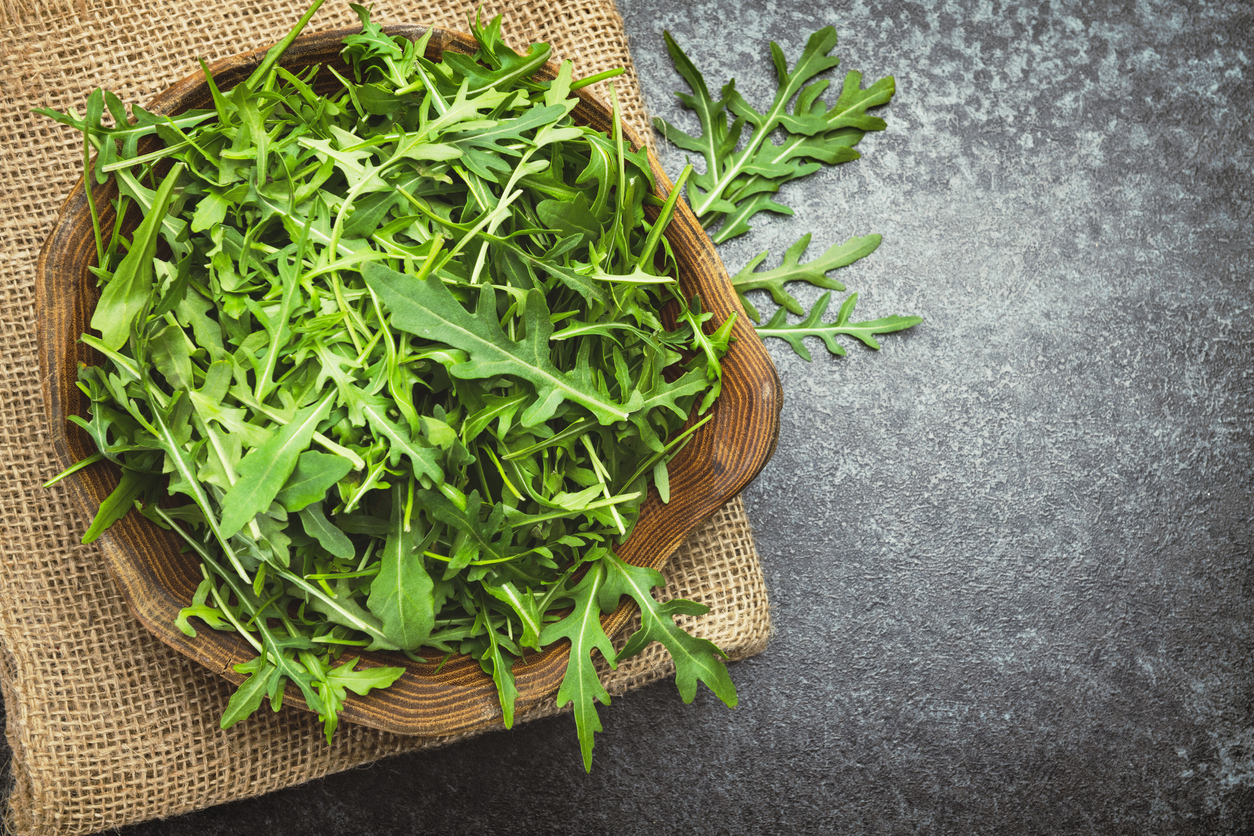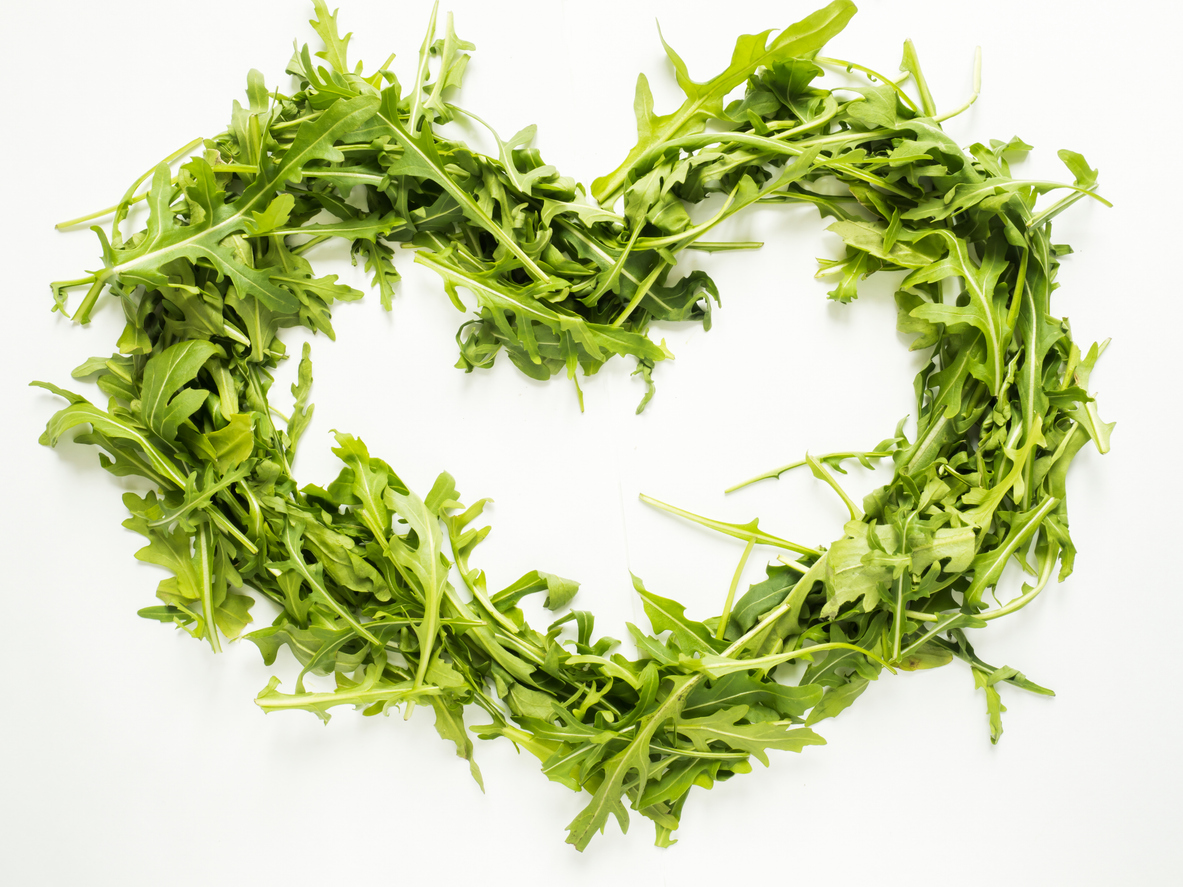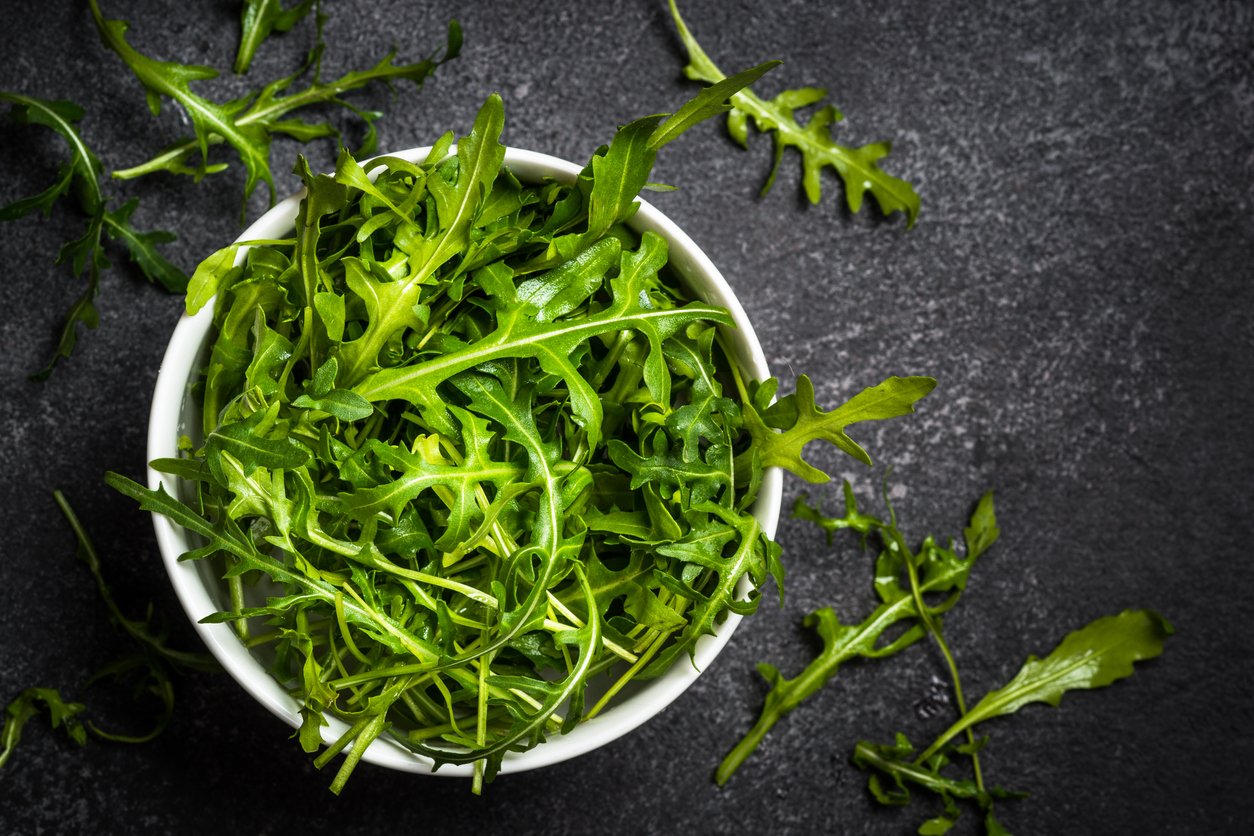I know I shouldn’t do this because of confidentiality, but I can’t help but eavesdrop on arugula’s therapy sessions. They usually go like this:
“I don’t understand why I’m so underrated! I’m the highest in plant-based nitrates, and I’m even an aphrodisiac! I know my taste is strong — I often get the message that I’m ‘too much’ — but hey, I’m just being me. What do spinach and kale have that I don’t?”
Arugula — known as rocket in the UK — has a point. It’s not nearly as popular as other leafy greens, largely due to its spicy and slightly bitter taste.
Arugula was brought to North America by British colonists before the founding of the United States. And it waited in relative obscurity, except in traditional Italian American cuisine, until it gained some popularity as a culinary ingredient in the 1990s.
Restaurants wanting to broadcast a more gourmet vibe started including arugula in salads (replacing or enhancing romaine and iceberg lettuce). And lately, it’s become a popular topping for pizza and flatbread.
This jump from traditional working-class Mediterranean cuisine to the pinnacle of fine dining probably sets arugula’s therapeutic progress back by decades. Let’s listen in on another therapy session.
“And just when I was starting to get popular, people made fun of Obama for complaining about the price of arugula at Whole Foods when he was campaigning in Iowa in 2008. They called it ‘Arugula-Gate’ — can you even imagine? Me? A symbol of elitism? I’ve been feeding hardworking Italian American families, and neglected in backyard gardens, for decades — and now I’m associated with out-of-touch rich people. It’s so unfair!”
I empathize with arugula. Rather than being a flash point in the culture wars, it’s a remarkably healthy green that deserves some respect.
Whether you’re new to arugula, harbor skepticism, or already know and love this zesty green, read on to find out just how good arugula can be for you.
What Is Arugula?

Arugula is a leafy green in the brassica family, which includes other cruciferous veggies like cauliflower, kale, cabbage, broccoli, and bok choy. The name “cruciferous” — cross-forming — refers to the shape made by the four petals of their flowers.
Both common names for the plant — arugula and rocket — derive from its botanical names: Eruca sativa (cultivated rocket) or Eruca vesicaria (bladder rocket), depending on the variety. Eruca is the Latin word for caterpillar, which probably refers to the garden pests that love to chomp down on the nutritious leaves. Arugula is native to the region stretching from the Mediterranean Sea into western Asia.
Arugula has a long history as a purported aphrodisiac, probably due to its sharp flavor. The Roman poet Virgil wrote that the plant “excites the sexual desire of drowsy people.” (I would expect no less from a plant called “rocket.”)
When you encounter the plant in a market, you’ll typically find it bagged in individual leaves. It looks a lot like it tastes: The pointy, somewhat jagged leaves are slightly bitter and peppery, which makes it a bit of an acquired taste for some people. The word that pops into my mind when I chew arugula is “feisty” — which I think of as a positive trait.
Arugula is grown primarily as a salad green but has many other culinary applications. If you’re curious, here’s an article about cooking with arugula that includes a bunch of delicious recipes.
Arugula Nutrition
Arugula, like its cruciferous cousins, is a nutritional powerhouse. A 100-gram serving (about two cups, packed very loosely) will deliver the following:
- 25 calories
- 3.7 grams of carbohydrates
- 2.6 grams of protein
- 1.6 grams of fiber
- 17% of the daily value (DV) of vitamin C
- 12% DV of calcium
- 8% DV of iron
- 8% DV of potassium
- 90% DV of vitamin K1
- 24% DV of folate
- 13% DV of vitamin A
Important Compounds in Arugula

However, the above list of vitamins and minerals doesn’t come close to telling the full story of arugula’s beneficial pharmacopeia. It’s rich in many phytochemical compounds that act as antioxidants — fighting inflammation and supporting your cardiovascular system.
Flavonols
Arugula is a rich source of flavonols like quercetin, kaempferol, and isorhamnetin, which are awesome polyphenol antioxidants. Arugula is an especially rich source of kaempferol, which is highly anti-inflammatory, and has been shown to interfere with many signaling pathways required for cancer cells to survive.
Despite being one of the lesser-known cruciferous veggies, arugula may win the prize for the strongest antioxidant activity of the family. (Actually, I don’t think there is such a prize yet, but there should be. Can you imagine the Food Academy Awards? “And the Oscar for most kaempferol in a salad green goes to…” That would probably make arugula feel a lot better about itself. Although it might get a tad boring if the same vegetable won in its category every single year.)
Nitrates
Nitrates from animal products are problematic for health, but nitrates are excellent when they come from fruits and vegetables. Your body converts the plant-based nitrates into nitric oxide gas, which does a lot of great things, including helping your cardiovascular system operate at peak capacity.
Athletes seeking top performance have been known to drink beet juice before competitions, considering it a kind of legal doping. It turns out that while beet juice is, in fact, high in nitric oxide-producing nitrates, it pales in comparison to arugula, which has the highest levels ever measured in a common food.
Isothiocyanates
Another group of beneficial compounds you’ll get from arugula are isothiocyanates, which are formed from sulfur-containing molecules in cruciferous vegetables known as glucosinolates. Raw arugula has some of the highest amounts of glucosinolates of any cruciferous veggie, rivaled only by the also-spicy mustard green (and topped only by the condiments horseradish and wasabi).
Two of the most potent isothiocyanates are sulforaphane and erucin. You may recognize that second one — it comes from eruca, which, of course, is our beloved rocket or arugula. These isothiocyanates can fight cancer by reducing the activation of carcinogens and increasing the body’s ability to detoxify them.
Arugula Health Benefits
Because arugula isn’t a hugely popular vegetable (this is why we might need those Veggie Oscars!), there aren’t a lot of studies that look at its health effects specifically. There is, however, a great deal of “circumstantial” evidence on the effects of the compounds mentioned above, both in a variety of vegetables and in test-tube studies.
Is Arugula Good for Your Heart?

A 2016 study looked at the effects of arugula and other vegetables on the levels of nitric oxide (a gas that acts as a signaling molecule, telling blood vessels to dilate and thus regulating blood pressure) in healthy adults. Arugula performed like a true star — consumption of it led to a six-fold increase in nitric oxide levels.
A lot of the evidence for the cardiovascular health benefits of arugula is “excellence by association.” As we’ve seen, arugula belongs to the brassica family, known for compounds that protect your heart.
If we’re naming names, the glucosinolates and isothiocyanates found in arugula act as antioxidants, specifically supporting heart and brain health. When these compounds break down in the body, they combat oxidative stress, inflammation, and cell damage — all crucial factors in the development of heart disease.
Isothiocyanates like erucin in arugula have also shown promising effects in reducing body mass index, fat accumulation, and blood pressure.
Arugula and Cancer
The glucosinolates in arugula aren’t just protective of cardiovascular health, however. Erucin and other bioactive compounds found in brassica vegetables have shown anticancer properties by inhibiting tumor growth and migration in various types of cancer.
A 2023 study out of Italy explored the potential anticancer effects of erucin on triple-negative breast cancer (TNBC) cells. Erucin was found to block the development of cancer in a whole bunch of ways.
Erucin inhibited cell proliferation (i.e., tumor growth), and induced apoptosis (programmed cell death) and autophagy (consumption of the cancerous cells by the body itself). It also prevented the generation of reactive oxygen species (which cause oxidative stress) and inhibited cell migration, invasion, and cancer colony formation in TNBC cells.
A 2019 study shed light on how consuming arugula could play a role in mitigating DNA damage from chemotherapy drugs, too. Researchers administered arugula leaf juice to mice who had been poisoned by an anticancer drug called cyclophosphamide. (Our view on the use of animals in medical research is here.)
The more arugula juice the mice received, the less DNA damage. It appears to have achieved this by boosting the levels of a couple of proteins involved in the body’s detoxification process. And the effect was replicated in human liver cells in vitro, suggesting that eating arugula could be very helpful when undergoing certain types of anticancer therapy.
All of this could be very good news for anyone who is facing or fearing a cancer diagnosis.
Arugula and Diabetes

Arugula also appears to help control type 2 diabetes. A 2017 study found that certain fatty acids found in the plant can help control blood sugar levels in lab tests on muscle, liver, and fat cells.
And in a 2019 study, researchers looked at the enzymes α-glucosidase and α-amylase, both of which can have the effect of raising blood sugar levels. The researchers learned that certain compounds found in our good friend arugula showed strong abilities to inhibit these enzymes — which means it might help to balance blood sugar.
Arugula Antimicrobial Effects
The seeds of arugula contain flavonoids, which are bioactive compounds known for their antimicrobial effects. Essential oils extracted from arugula have demonstrated activity against bacteria such as Staphylococcus aureus and Bacillus cereus, and appear to be able to stem bacterial infections.
A 2022 study compared 17 different essential oils and found that arugula seed oil was the most active, and, thus the most effective against disease-causing bacteria that can affect newborn babies. (Other contenders that did almost as well — the Vegetable Oscar runner-ups in the category — included oils from wheat germ, cinnamon, parsley, dill, and onion.)
Arugula’s isothiocyanates have also been studied for their antimicrobial effects against various pathogens. Research has shown that some of them can help combat infections caused by bacteria, including those with antibiotic-resistant properties.
Arugula and Bone Health

Arugula, like other members of the brassica family, contains organosulfur compounds like glucoraphanin and sulforaphane. Research suggests that these compounds may help in preserving skeletal health by promoting bone formation and inhibiting bone resorption. Consuming arugula may contribute to bone health by maintaining bone strength and reducing the risk of bone-related issues like osteoporosis.
Additionally, arugula and other green leafy vegetables contain vitamin K1, which may help with bone metabolism and calcium balance.
Erucin also appears to support bone health by regulating the activity of osteoclasts (which break down bone tissue) and osteoblasts (which form new bone). A 2022 study found that erucin may affect these cells in such a way as to prevent excessive bone loss without interfering with normal bone formation.
Potential Side Effects of Eating Arugula
Arugula has so many health benefits, I’d understand if you wanted to stuff yourself with the leaves all day long. But before you become a rocket-aholic, there are a few things to consider.
Arugula and Drug Interactions

Arugula may interact with a class of pharmaceuticals called blood thinners that includes the well-known drug warfarin. That’s because arugula is rich in vitamin K, which is important to the blood clotting process. If you are taking one of these drugs, it’s generally advised to keep your vitamin K intake consistent, so you don’t have to worry about over- or underdosing. So the takeaway isn’t to avoid arugula entirely but to avoid binging one week and abstaining the next. And it could be good to talk with your health care provider before consuming a large quantity of it.
Arugula Antinutrients
Many plants contain compounds, often referred to as “antinutrients,” that inhibit the absorption of some nutrients. One group of these compounds is oxalates. While some leafy greens such as spinach are high in oxalates, arugula is quite low — one study actually found zero oxalates in arugula.
Another class of antinutrients is goitrogens, which can impact thyroid function in people who are deficient in iodine. If that’s you, then ingesting large quantities of raw arugula — like if you need a wheelbarrow to get it from your shopping cart to your home — may risk inducing hypothyroidism.
However, if consumed in normal amounts as part of a balanced diet, arugula is unlikely to cause thyroid issues even in someone with thyroid problems or iodine deficiency.
Arugula Pesticides

There’s a reason most leafy greens are grown with lots of pesticides: They’re so healthy that bugs just can’t resist. And arugula typically gets the same pesticide treatment as kale and spinach, both of which are members of the Environmental Working Group’s “Dirty Dozen” — the 12 plants with the most worrisome amounts and kinds of pesticides, and thus the plants to obtain organically grown if possible.
Arugula, in particular, may be treated with organophosphate herbicides like bensulide, which is extremely toxic (many of its organophosphate relatives have already been banned by the US Environmental Protection Agency).
For these reasons, you may prefer to buy organic arugula if available and affordable.
Arugula produced in California and Arizona is also potentially subject to food safety risks because of yucky runoff from nearby large livestock feeding operations. That’s why I always wash my store-bought arugula before eating it.
You might also consider growing it yourself — it’s an easy-to-cultivate plant that, according to one arugula farmer, “thrives well on total abuse.” (If arugula ever opens up to you about its self-esteem issues, please don’t share that quote. Doing so just wouldn’t be nice.)
Give Arugula the Love it Deserves
Arugula is a culinary and nutritional gem that deserves recognition and inclusion on your plate. With its feisty, zesty flavor, it adds a unique twist to dishes, while its impressive array of vitamins, minerals, and especially antioxidants contributes to its health benefits.
From bolstering bone health with vitamin K to protecting against chronic diseases with its potent phytochemicals, arugula offers a holistic approach to wellness. Its versatility in the kitchen allows for endless culinary explorations, from fresh salads to savory dishes, making it easy to incorporate into daily meals.
Tell us in the comments:
- Are you a fan of arugula? How do you prepare it?
- What’s one thing that surprised you about the health benefits of arugula?
Featured Image: iStock.com/Nadiia Borovenko




